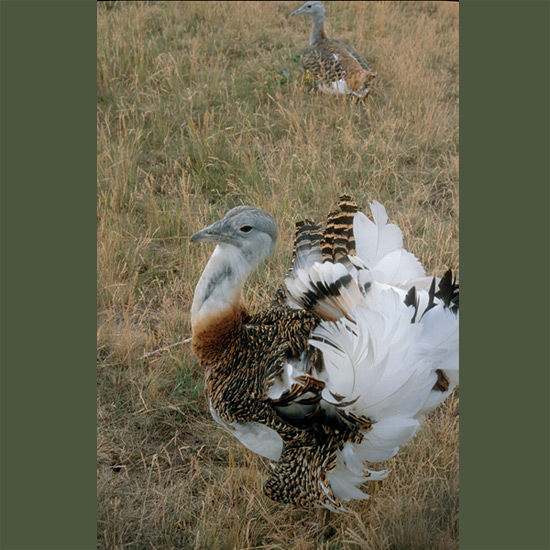Hortobagy National Park
Trumpeting common cranes fill the skies in fall as in bygone days over steppe-grassland “puszta” of Hortobagy National Park, 312-square-mile (810-km2) U.N. World Heritage Site on the Great Hungarian Plain, which has come to be regarded as a premier birding spot of Europe. Up to 72,000 of these tall, stately birds swoop over Hortobagy’s vast waving marsh grasses, rising and falling in great waves of 20,000 or so with a rushing sound like the wind en route to feeding grounds or nightly roosts.
Rarities in numbers seldom seen elsewhere are here, either in migration or as permanent residents. Over 1,000 long-legged, endangered great bustards, one of the world’s largest birds—largest that can also fly—known as the “Hungarian ostrich,” peer over tall grasses, males up to a yard (1 m) tall, weighing almost 50 pounds (22 kg). Drab and hard to see in everyday plumage, males are spectacular in courtship display when they throw their heads back, with tails forward and wings almost inside-out to all but cover themselves with vibrating snowy feathers.
Over 1,200 pairs of elegant white-winged black terns dip gracefully for insects and tiny fish on the water’s surface. Over 600 pairs of sweetsinging aquatic warblers claim foxtail meadow territories. Over 100 pairs of swift saker falcons patrol airways—fearless hunters that readily rival imperial eagles and go after prey as large as geese and hares— distinguishable from peregrines, also here, by slimmer body, longer tail, and wider, blunter wings.
Sociable, noisy crow-like rooks and protected, rare spoonbills, glossy ibises and purple and black-crowned night herons nest colonially in lowland copses, also home to nesting kestrels, long-eared owls, red-footed falcons, and in recent years to imperial eagles and long-legged buzzards. Reedbeds shelter families of bitterns, threatened corncrakes, pygmy cormorants, great reed warblers, and bluethroats with brilliant azure bibs. Water lilies hide floating nests of rednecked and black-necked grebes. Collared pratincoles and Kentish plovers are content with nest scrapes on bare ground. Altogether almost 350 bird species are here.
In late summer to early fall red-footed falcons hunt in loose flocks, sometimes 100 or so. Ferruginous ducks, handsome pochards, and red-breasted, greater, and lesser white-fronted geese are on ponds. Grasshopper hordes attract flocks of white storks, rose-colored starlings, and Eurasian dotterels to the flat “puszta” plain.
Shorebirds forage on mudflats around some 24 square miles (60 km2) of fish ponds originally dug for economic purposes, now ideal habitat for broad-billed sandpipers, red-necked phalaropes, Temmink’s stints, and rare slender-billed curlews.
Up to 28 white-tailed eagles can be around in winter along with great gray shrikes, bearded tits, and little owls.
Sharing open grasslands are now-rare descendants of domestic agricultural grazers of ancient origin which made Hortobagy (pronounced Horto-baj) possible, the result of more than 2,000 years of mutually helpful coexistence with humans. After herdsmen cleared woodlands, grazers kept the wet sodic plain, formed by centuries of saline flooding from the Tisza River, fertile and open, attracting and permitting survival of the remarkable collection of species here today—spiral-horned long-haired racka sheep, Hungarian gray longhorn cattle (and their sometime- companions, short-toed larks), Mangalica pigs, Nonius horses and their herdsmen’s puli and komondor sheepdogs.
The park has trails, 20–30 lookout towers, and offers a two-hour bus tour April–October. Some of the more interesting parts require a guide, going by horse, carriage, or afoot.
Threats include disastrous cyanide pollution from a gold mine spill into the Tisza River, longterm region-wide effects still not known.
Most international visitors arrive by air in Budapest, three hours’ drive (124 miles/200 km) west of Hortobagy. Best way to get around Hungary (though costly) is by rental car since bus and rail transport is limited. A wide range of good accommodations, including campsites, can be found in most places (as in Debrecen 25 miles/39 km east of Hortobagy).
Much of the year is pleasant, though temperatures can range from above 85°F (29°C) in summer to below freezing in winter. Best times are late April to mid–late May for migrations; May for breeding, including great bustards displaying; September–October for common cranes, also flocks of great bustards and lesser white-fronted geese.
ALSO OF INTEREST
Kiskunsag National Park, a short distance southwest of Hortobagy and almost as impressive,with similar birds.
Koros-Maros National Park, near Szvaras, with great bustards, otters, little egrets, protected snail-forest (12 snail species), trails, cycle paths, visitor center.
Lake Ferto-Hansag National Park in Hungary’s far northwest section of the Neusiedlersee,with woods and marshes, wading birds, red-crested pochards, little crakes, penduline tits, warblers uncommon elsewhere.
Zemplen Forest Reserve northeast of Miskolc, one of a number of (mainly broadleaved) forested hill ranges across Hungary’s north with black storks, collared and red-breasted flycatchers, eight woodpeckers including black, spotted, green, and Syrian, great raptors including Ural and eagle owls, imperial, golden, booted, and lesser spotted eagles.
White storks nest throughout the country on chimneys and over 1,500 pylon supports erected for them by the Hungarian Ornithological Society.
Click on image for description.
Visit Tripadvisor®
for lodging information about this Reserve
HORTOBAGY NATIONAL PARK as well as...
Kiskunsag National Park
Koros-Maros National Park
Lake Ferto-Hansag National Park
Zemplen Forest Reserve
Advertisement


